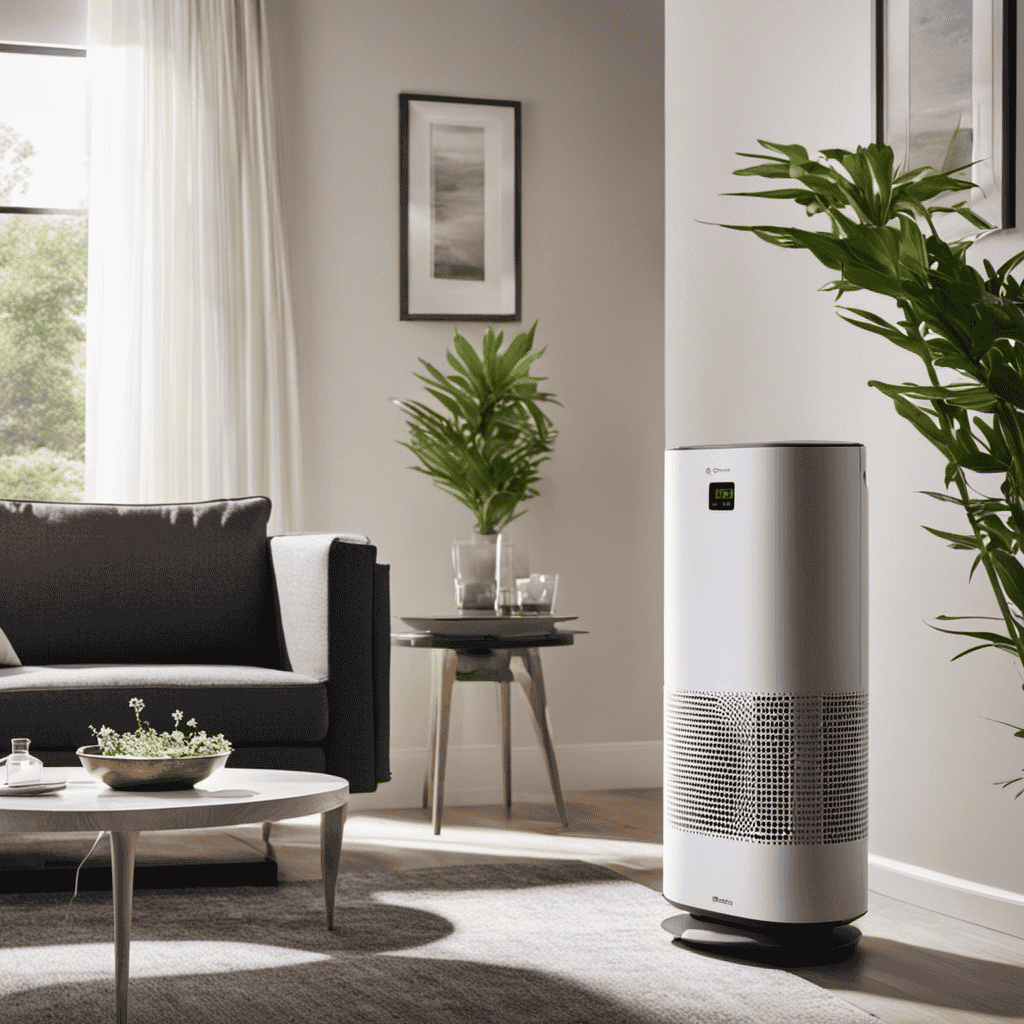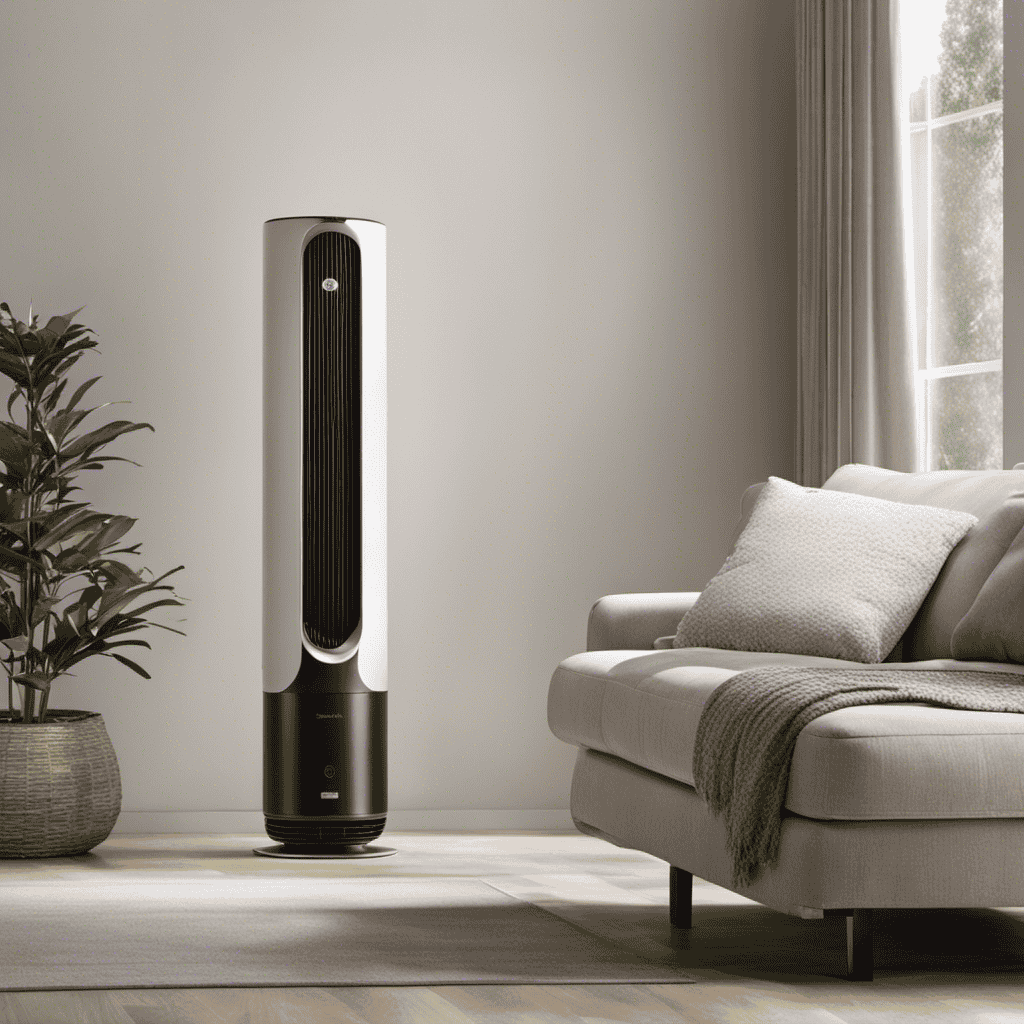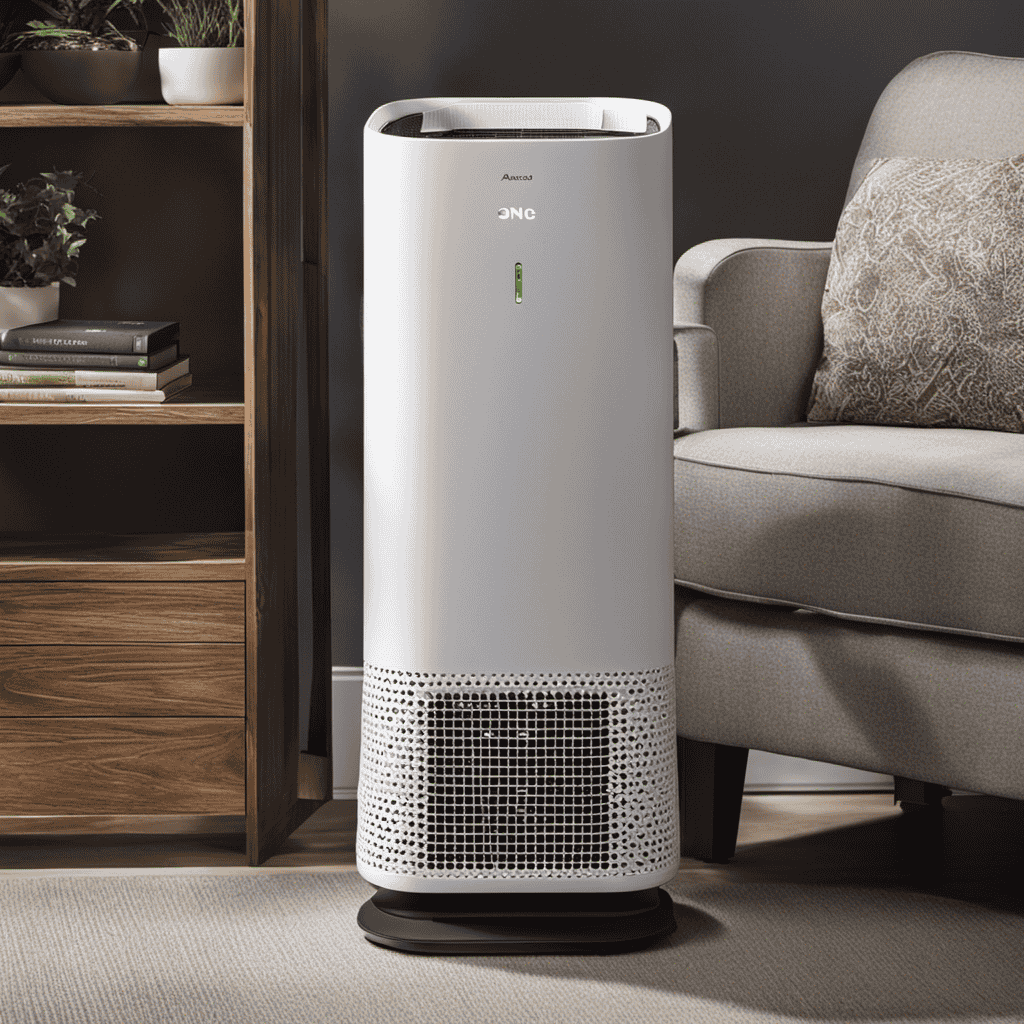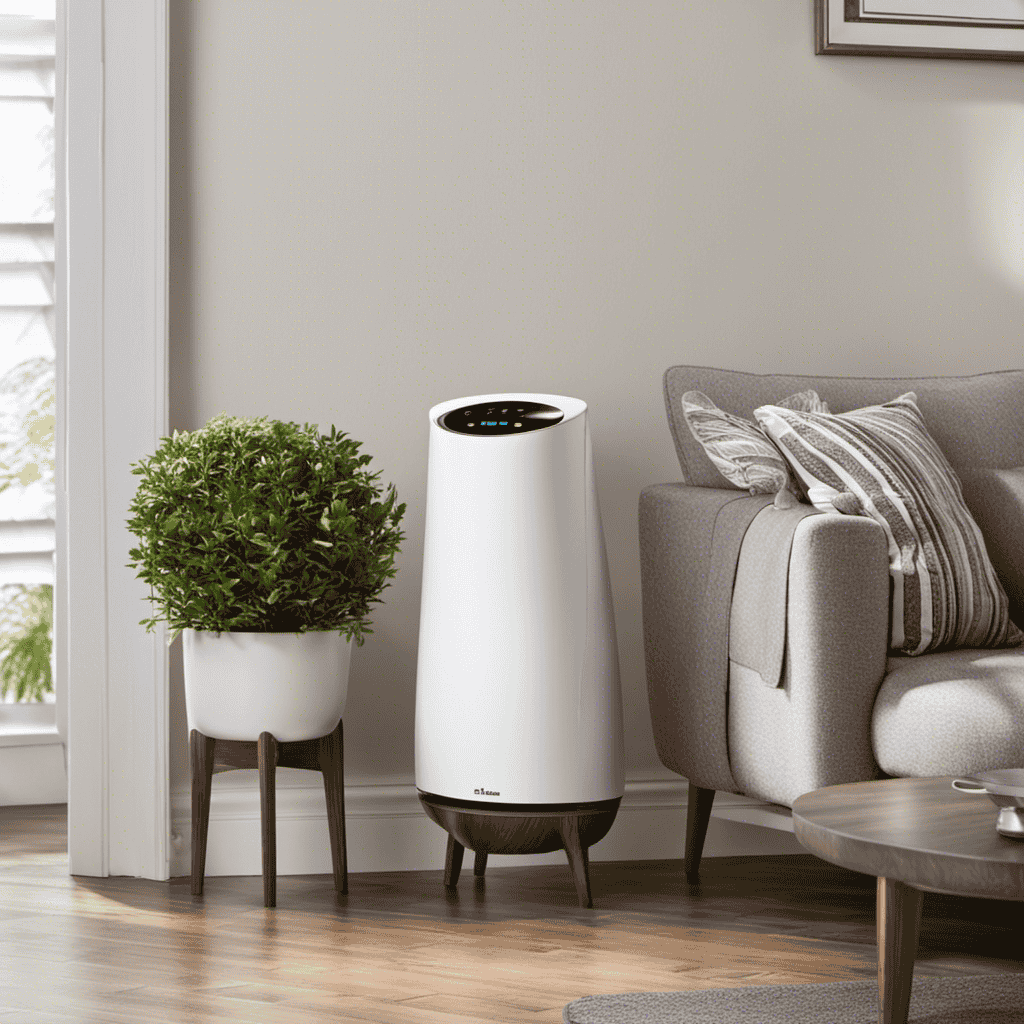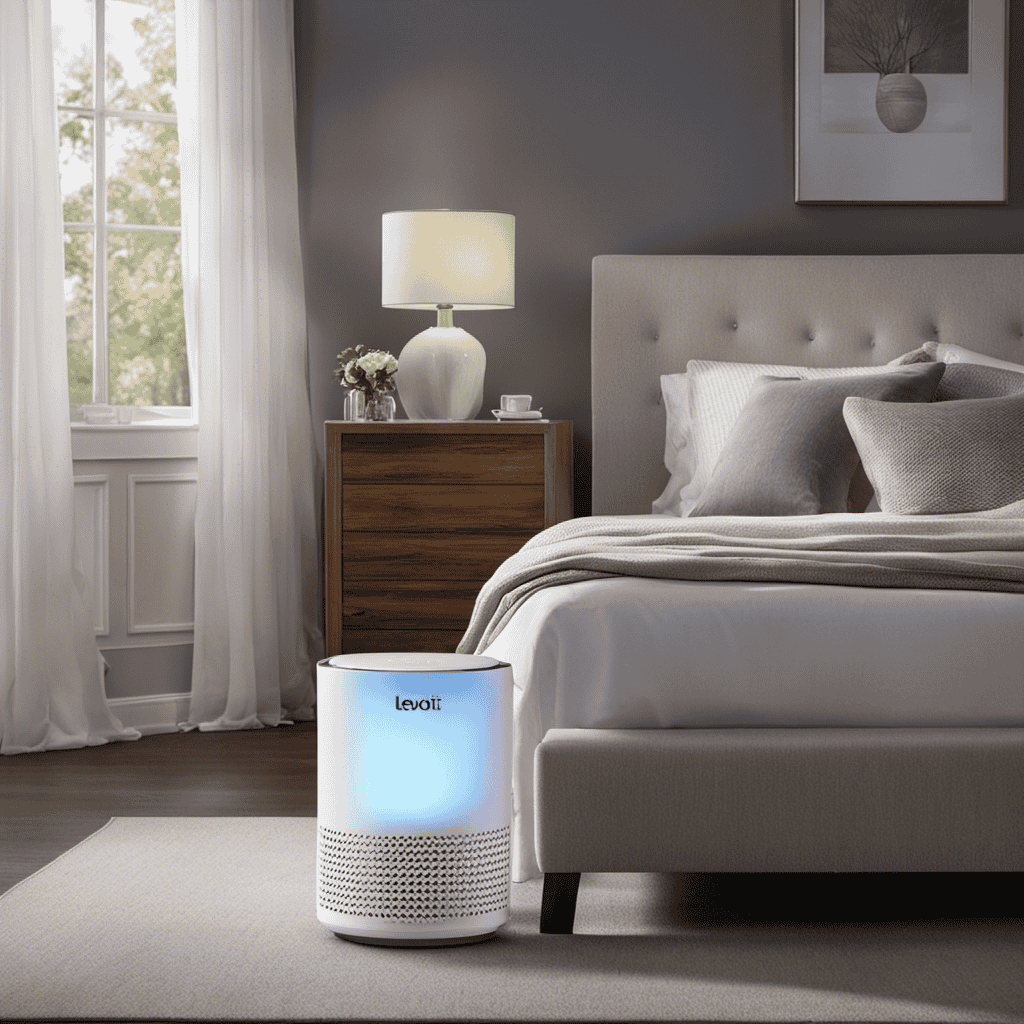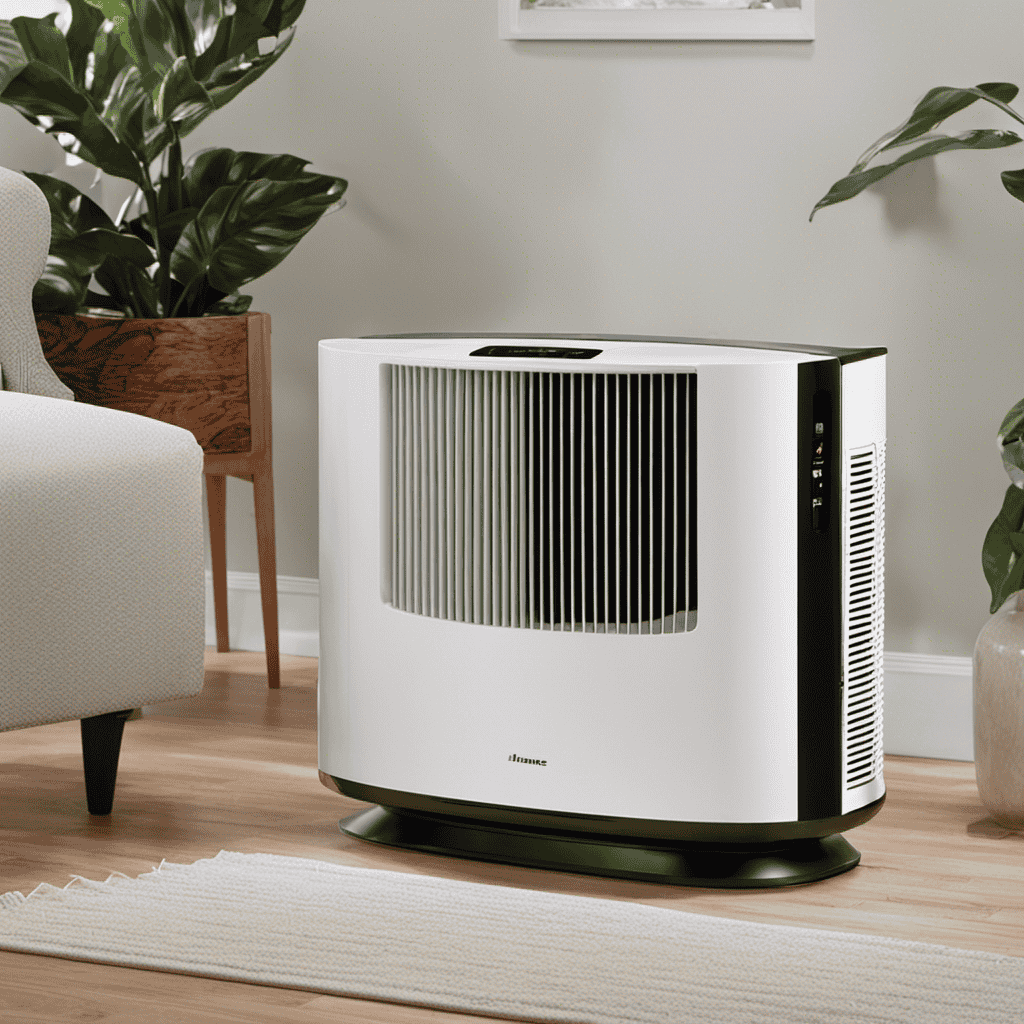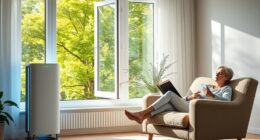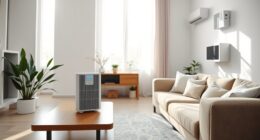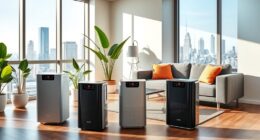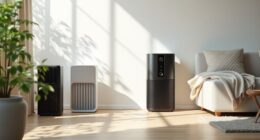Standing in my house, inhaling a deep breath of clean, fresh air, it makes me ponder: what role does ozone play in an air purifier?
This question has led me on a journey of scientific exploration, where I have delved into the role of ozone in air purification, how it is generated in air purifiers, and its impact on indoor air quality.
Join me as we uncover the effectiveness of ozone in eliminating airborne contaminants, the potential health risks it poses, and the importance of ozone regulation in air purifier design.
Key Takeaways
- Ozone neutralizes harmful pollutants in the air by breaking down organic and inorganic compounds.
- Ozone eliminates odors by breaking down odor-causing molecules.
- Controlled amounts of ozone should be used to avoid harm to human health.
- Ozone can be generated through corona discharge or ultraviolet light, and the amount of ozone generated can be controlled for optimal air purification.
The Role of Ozone in Air Purification
Ozone plays a crucial role in air purification by neutralizing harmful pollutants. It is a powerful oxidizing agent that can break down organic and inorganic compounds found in the air.
The ozone generation process involves using either corona discharge or ultraviolet light to convert oxygen molecules (O2) into ozone (O3).
When ozone is introduced into an air purifier, it reacts with pollutants such as bacteria, viruses, mold, and volatile organic compounds (VOCs). This reaction leads to the oxidation and decomposition of these pollutants, rendering them harmless.
Ozone also has the ability to eliminate odors by breaking down the odor-causing molecules. However, it is important to note that ozone should be used in controlled amounts, as high levels can be harmful to human health.
How Ozone Is Generated in Air Purifiers
To generate ozone in an air purifier, you simply need to adjust the settings and let the machine do its work. Ozone is a powerful oxidizing agent that can effectively eliminate airborne pollutants and odors. It is produced through a process called corona discharge, where oxygen molecules are split into individual atoms and then recombine to form ozone. This process occurs when an electrical discharge is passed through a dielectric material, such as ceramic plates or glass tubes, that contain a small amount of oxygen. The electrical discharge breaks apart the oxygen molecules, creating free oxygen atoms that can then combine with other oxygen molecules to form ozone. This ozone production is regulated by the air purifier’s settings, allowing you to control the amount of ozone generated for optimal air purification.
| Column 1 | Column 2 | Column 3 |
|---|---|---|
| Improved air quality | Fresh and clean scent | Reduction in allergens |
| Elimination of odors | Removal of bacteria and viruses | Reduction in respiratory symptoms |
| Elimination of mold and mildew | Reduction in volatile organic compounds | Enhanced well-being |
Understanding Ozone’s Impact on Indoor Air Quality
You can better understand how ozone affects the quality of the air inside your home. Ozone, a gas composed of three oxygen atoms, plays a crucial role in reducing indoor pollutants and ensuring a healthy environment. Here are some key points to consider:
- Ozone effectively neutralizes odors by breaking down volatile organic compounds (VOCs) into harmless byproducts.
- Ozone can eliminate bacteria, viruses, and mold spores, improving overall indoor air quality.
- However, high levels of ozone can be harmful to respiratory health, causing coughing, chest tightness, and shortness of breath.
- It is important to maintain ozone levels within safe limits to avoid any adverse effects.
Understanding ozone’s impact on respiratory health and its role in reducing indoor pollutants is crucial for maintaining a healthy home environment. Now, let’s explore the effectiveness of ozone in eliminating airborne contaminants.
The Effectiveness of Ozone in Eliminating Airborne Contaminants
When it comes to discussing ozone’s purification capabilities and the health risks associated with it, I have found that there is a wide range of opinions and research available.
Ozone is known for its ability to eliminate airborne contaminants by oxidizing them, breaking down their molecular structure.
However, it is important to note that excessive exposure to ozone can have detrimental effects on human health, such as respiratory irritation and lung damage.
Ozone’s Purification Capabilities
Although ozone is effective at purifying the air, it can also have harmful effects on your health. Ozone’s role in air pollution is twofold: it can both contribute to the formation of harmful pollutants and help remove them from the atmosphere.
Here are some key points to consider:
-
Ozone is a highly reactive molecule that can react with various air pollutants, such as volatile organic compounds (VOCs) and nitrogen oxides (NOx), forming secondary pollutants like formaldehyde and ultrafine particles.
-
Ozone can irritate and damage the respiratory system, leading to symptoms such as coughing, chest tightness, and shortness of breath.
-
Prolonged exposure to high levels of ozone can worsen existing respiratory conditions, such as asthma and chronic obstructive pulmonary disease (COPD).
-
Ozone’s harmful effects are particularly pronounced in vulnerable populations, such as children, the elderly, and individuals with compromised immune systems.
It is important to strike a balance between air purification and potential health risks when considering the use of ozone-based air purifiers.
Health Risks of Ozone?
In my previous discussion, I explored the purification capabilities of ozone in air purifiers. While ozone can effectively eliminate odors and neutralize harmful pollutants, it is important to consider the potential health risks associated with its use.
Ozone is a reactive gas that can cause irritation to the respiratory system, leading to coughing, shortness of breath, and chest discomfort. Prolonged exposure to high levels of ozone may even result in lung damage and exacerbate existing respiratory conditions such as asthma.
Recognizing these concerns, regulatory bodies have set limits on the amount of ozone that air purifiers can emit to ensure the safety of users. It is crucial to strike a balance between the health benefits of ozone and the need for effective regulation to minimize potential risks.
The Potential Health Risks Associated With Ozone in Air Purifiers
There are potential health risks associated with ozone in air purifiers. Ozone exposure can have detrimental effects on respiratory health, leading to various respiratory conditions. It is important to be aware of these risks in order to make informed decisions about the use of air purifiers.
Here are some key points to consider:
- Ozone can irritate the respiratory system, causing coughing, wheezing, and shortness of breath.
- Prolonged exposure to ozone can lead to inflammation of the airways, exacerbating respiratory conditions such as asthma and bronchitis.
- Ozone can react with other air pollutants, forming harmful byproducts that can further contribute to respiratory problems.
- Individuals with pre-existing respiratory conditions, children, and the elderly are particularly vulnerable to the adverse effects of ozone exposure.
To protect your respiratory health, it is important to choose air purifiers that do not emit ozone or have ozone generation capabilities. Regular maintenance and proper use of air purifiers are also essential.
Ozone Vs. HEPA Filters: a Comparison of Air Purification Methods
When it comes to air purifiers, understanding the risks and benefits of ozone is crucial.
Ozone, a powerful oxidant, can effectively eliminate odors and kill certain bacteria and viruses. However, it can also be harmful to human health, especially in high concentrations.
Therefore, it is important to consider the effectiveness of HEPA filters as an alternative method for air purification. HEPA filters are highly efficient in removing particulate matter from the air, including allergens and pollutants.
Ozone Risks and Benefits
You should be aware of the risks and benefits of ozone in an air purifier.
Ozone is a reactive gas that can be produced by certain air purifiers to remove pollutants from the air. However, there are concerns about the potential harm ozone can cause to human health.
Here are some important points to consider:
-
Ozone regulation: The Environmental Protection Agency (EPA) has set limits on ozone emissions from air purifiers to protect public health. Make sure the air purifier you choose complies with these regulations.
-
Health risks: Ozone can irritate the respiratory system and worsen existing respiratory conditions such as asthma. Prolonged exposure to high levels of ozone can cause lung damage and other health problems.
-
Benefits of ozone: Ozone can effectively eliminate odors and kill certain bacteria and viruses in the air. It can also break down volatile organic compounds (VOCs) that contribute to indoor air pollution.
-
Ozone-free alternatives: If you are concerned about the potential risks of ozone, consider air purifiers that use alternative technologies such as HEPA filters or activated carbon filters. These methods are proven to be effective in removing pollutants without generating ozone.
HEPA Filter Effectiveness
HEPA filters are highly effective at removing airborne particles and allergens from the air. These filters work by using a dense network of fibers to trap particles as small as 0.3 microns in size. This means that common allergens like pollen, dust mites, pet dander, and mold spores can be effectively captured and prevented from circulating in the air.
The benefits of HEPA filters are well-documented, with studies showing significant improvements in indoor air quality and reductions in allergy and asthma symptoms. However, it is important to note that HEPA filters have limitations. They are not effective at removing gases, odors, or volatile organic compounds (VOCs) from the air.
Additionally, HEPA filters require regular maintenance and replacement to maintain their effectiveness. Despite these limitations, HEPA filters remain a popular choice for improving indoor air quality and reducing exposure to airborne pollutants.
Choosing the Right Method
To select the appropriate method for improving indoor air quality, it’s crucial to consider factors such as the size of the space, the specific pollutants present, and individual health needs. When comparing different air purifier methods, it’s important to weigh the pros and cons of ozone purification.
Here are some key points to consider:
-
Pros of ozone purification:
-
Effectively eliminates odors and volatile organic compounds (VOCs)
-
Can reach and neutralize pollutants in hard-to-reach places
-
Kills bacteria, viruses, and mold spores
-
Provides a chemical-free alternative for air purification
-
Cons of ozone purification:
-
Can be harmful to humans and pets when ozone levels are too high
-
Does not remove particulate matter such as dust and pollen
-
Requires proper ventilation to prevent ozone buildup
-
May not be suitable for individuals with respiratory conditions
When choosing an air purifier method, it’s important to consider these factors and weigh the benefits and drawbacks of ozone purification against other options available.
Ozone’s Ability to Remove Odors and Vocs From the Air
Using an air purifier with ozone can help eliminate odors and VOCs from your surroundings. Ozone, a molecule composed of three oxygen atoms, has the ability to react with and break down various odor-causing compounds and volatile organic compounds (VOCs). When ozone comes into contact with these substances, it undergoes chemical reactions that result in the destruction of the odors and VOCs. This is due to ozone’s highly reactive nature and its role in initiating oxidation reactions.
However, it is important to note that ozone can also have negative effects on human health, particularly on lung function. High levels of ozone can cause respiratory symptoms and can exacerbate existing respiratory conditions, such as asthma. Therefore, it is crucial to carefully consider ozone levels and its potential impact on lung health when using an air purifier.
Transitioning to the subsequent section, let’s explore ozone’s impact on allergens and asthma triggers.
Ozone’s Impact on Allergens and Asthma Triggers
When considering the impact of ozone on allergens and asthma triggers, you should be aware of the potential risks it may pose to your respiratory health.
Ozone, a molecule composed of three oxygen atoms, is known to have both beneficial and harmful effects on the respiratory system. Here are some key points to keep in mind:
- Ozone can irritate and inflame the airways, leading to symptoms such as coughing, wheezing, and shortness of breath.
- Prolonged exposure to high levels of ozone can damage lung tissue and impair lung function.
- Individuals with pre-existing respiratory conditions, such as asthma, are particularly susceptible to the negative effects of ozone.
- Ozone can also interact with other pollutants in the air, forming harmful compounds that can further exacerbate respiratory symptoms.
Understanding ozone’s effect on the respiratory system and its impact on lung function is crucial in making informed decisions about air purifiers and other devices that may produce ozone as a byproduct.
The Importance of Ozone Regulation in Air Purifier Design
Ozone’s impact on health is a critical consideration when designing air purifiers. While ozone can be effective at eliminating pollutants, it can also have harmful effects on human health.
The challenge lies in striking the right balance between effectiveness and safety, ensuring that air purifiers efficiently remove pollutants while minimizing ozone levels to protect human well-being.
Ozone’s Impact on Health
Ozone can have negative effects on health when present in high concentrations. Exposure to high levels of ozone can lead to a range of health issues, both in the short term and long term. Here are some key points to consider:
-
Ozone exposure can cause irritation to the respiratory system, leading to coughing, throat irritation, and chest discomfort.
-
Prolonged exposure to high levels of ozone can result in lung inflammation and damage, which may lead to the development or exacerbation of respiratory conditions such as asthma and chronic obstructive pulmonary disease (COPD).
-
Studies have also suggested that long-term exposure to ozone may increase the risk of cardiovascular diseases, including heart attacks and strokes.
-
Children, the elderly, and individuals with pre-existing respiratory or cardiovascular conditions are particularly vulnerable to the harmful effects of ozone exposure.
Understanding the potential long-term effects of ozone exposure is crucial in balancing the effectiveness and safety of air purifiers.
Balancing Effectiveness and Safety
To ensure you strike the right balance between effectiveness and safety, consider factors such as air quality, room size, and your specific needs when choosing an air purifier.
Balancing effectiveness and safety is crucial because while air purifiers can improve indoor air quality by removing pollutants, they can also pose potential risks if not used correctly.
Some air purifiers emit ozone, a gas that can be harmful to human health in high concentrations. Ozone can irritate the respiratory system and worsen conditions like asthma and allergies.
Therefore, it is important to choose an air purifier that does not produce ozone or produces it in safe levels. Look for air purifiers that are certified as ozone-free or low ozone-emitting to ensure the safety and effectiveness of your indoor air purification.
Ozone-Free Air Purifiers: Are They a Better Option
Did you know that ozone-free air purifiers may be a better option for you? When considering the effectiveness of air purifiers, it is essential to weigh the pros and cons of different technologies.
Here is a comparison between ozone and ozone-free air purifiers:
- Ozone-free air purifiers:
- Effectiveness: Ozone-free air purifiers are highly effective at removing particles such as dust, pollen, and pet dander from the air.
- Safety: They do not produce ozone, making them a safer option for individuals with respiratory conditions or sensitivities.
- Odor removal: Ozone-free purifiers excel at eliminating unpleasant odors, such as cooking smells or tobacco smoke.
- Energy-efficient: These purifiers consume less energy, resulting in lower electricity bills.
On the other hand, ozone-generating air purifiers have drawbacks:
- Ozone production: Ozone generators produce ozone, which can irritate the respiratory system and worsen asthma symptoms.
- Limited effectiveness: While ozone can eliminate some odors and kill certain bacteria, it is less effective at removing particles from the air.
- Safety concerns: Ozone can be harmful when inhaled in high concentrations, and long-term exposure may lead to lung damage.
Considering these factors, opting for an ozone-free air purifier can provide you with effective and safer indoor air purification.
Tips for Using Ozone-Generating Air Purifiers Safely
When using an ozone-generating air purifier, it’s important to follow these safety tips to minimize the risks associated with ozone exposure. Ozone, a molecule composed of three oxygen atoms, can be harmful to human health when present in high concentrations. To ensure safe usage of ozone-generating air purifiers, consider the following precautions:
| Precaution | Description |
|---|---|
| Limit Exposure | Minimize the time spent in the room where the purifier is operating. |
| Ventilation | Ensure proper ventilation by opening windows or using fans to disperse ozone. |
| Follow Manufacturer’s Instructions | Adhere to the recommended usage guidelines provided by the purifier’s manufacturer. |
| Monitor Ozone Levels | Use an ozone detector to measure and maintain safe ozone concentrations. |
Frequently Asked Questions
Can Ozone in Air Purifiers Cause Harm to Humans?
Yes, ozone in air purifiers can cause harm to humans. Ozone safety precautions must be taken to avoid long term effects of ozone exposure, such as respiratory problems, lung damage, and exacerbation of existing conditions.
Are Ozone-Free Air Purifiers More Effective in Eliminating Airborne Contaminants?
Ozone-free air purifiers, like a gentle breeze, effectively eliminate airborne contaminants. Their advanced filtration systems trap and remove particles, ensuring cleaner air without the potential harm associated with ozone.
How Does Ozone Impact the Removal of Odors and Vocs From the Air?
Ozone plays a crucial role in air purification by effectively removing odors and VOCs from indoor air. It acts as a powerful oxidizing agent, breaking down pollutants and improving overall indoor air quality.
Does Ozone Have Any Effect on Allergens and Asthma Triggers in the Air?
Ozone, found in some air purifiers, can have an effect on allergens and asthma triggers in the air. However, long term exposure to ozone can be harmful to respiratory health and have negative effects on the body.
What Are Some Tips for Safely Using Ozone-Generating Air Purifiers?
When using ozone-generating air purifiers, it is crucial to follow safety guidelines. Tips for safe use include ensuring proper ventilation, limiting exposure time, and keeping ozone levels within recommended limits. Neglecting these precautions can pose potential dangers.
Conclusion
In conclusion, it is crucial to consider the role of ozone in air purifiers. While ozone can effectively eliminate airborne contaminants, it is important to be aware of its potential health risks.
Ozone can have adverse effects on allergens and asthma triggers, making it necessary to regulate its presence in air purifier design. Additionally, opting for ozone-free air purifiers may be a safer choice.
By using ozone-generating air purifiers safely and following guidelines, we can ensure cleaner and healthier indoor air quality.
